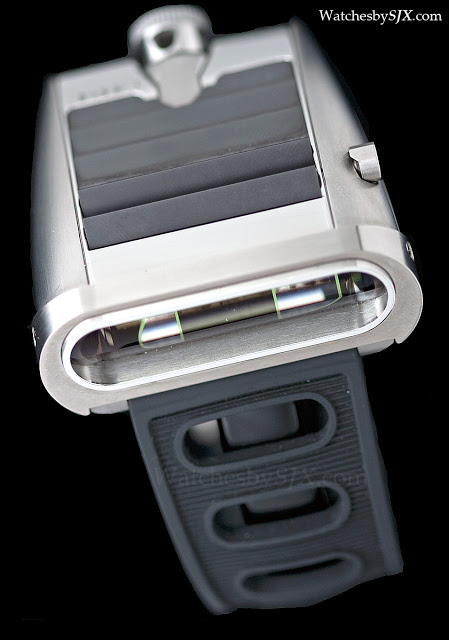Hands-on with the MB&F HM5 “On the Road Again” (with live pictures and pricing)

MB&F has just unveiled its latest horological machine: inspired by sports cars of the seventies and the brand’s new entry level machine, the Horological Machine No. 5, in zirconium.
Being a child of the seventies, Maximilian Büsser’s fifth Horological Machine takes inspiration from two objects from the seventies – sports cars like the Lamborghini Miura and the Amida Digitrend. The MB&F HM5 is many things: a driver’s watch, a jump hour, a sports watch. But above all the HM5 is a tribute to the automobile. However, rather than having a steering wheel rotor and brake caliper pushers like all other car-themed watches, HM5 has been cleverly conceived in its entirety as an automotive watch. From the back the HM5 resembles the sloped, vented rear of a Miura and other seventies sports cars. Of all the Machines I think the HM5 might be the one with the greatest longevity in terms of design. Compared to the other Machines, it is trying less hard to be different.
| Some things look best from the back |
The MB&F HM5 is driver’s watch with jumping hour, which can be adjusted forwards and back. Developed by Jean-Francois Mojon and Vincent Boucard of Chronode, the movement has two oversized and overlapping discs for maximum readability. It is built on the Girard-Perragaux cal. 3100, as with most of the Machines.
| The engine |
But as with all Machines, it is the case that is most unusual. First, the case construction is like that of an automobile. The water-resistant chassis contains the movement and crystal, and onto that the zirconium bodywork is screwed on. Because it’s water-resistant, this watch is supplied with a rubber strap, a first for MB&F.
| The chassis of the HM4 containing the movement |
From the side the zirconium case of the HM5 is strongly reminiscent of the MB&F HM4 Thunderbolt, which was its immediate predecessor in the HM series.
| The screws that secure the zirconium bodywork to the inner movement capsule |
On the two of the watch are a pair of louvres which can be opened by a small lever on the case. These allow sunlight into the case, which charges up the Super Luminova.
| The lever for the louvres |
Those same louvres will also allow water into the outer zirconium case – but not the inner movement module which is sealed – so a pair of drainage vents are incorporated into the back of the case, much like exhaust pipes.
| The drainage vents on either side of the crown |
Notably, the time display of the watch is actually flat, parallel to the movement. However, a wedge-shaped sapphire prism reflects the time display 90° onto the front panel of the watch. That is why the numerals – which incidentally are a sandwich construction with two mineral glass discs entirely coated in Super Luminova with masking on top – are printed in reverse.
And attached to the front of the prism is a convex crystal that magnifies the numbers by 20%, improving legibility.
| The crystal |
The dimensions of the watch are 51.5 mm by 49 mm, and it is 22.5mm high. On the wrist it certainly makes a statement, like any other MB&F creation.
Only 66 pieces will be made in zirconium for 2012-2013. In subsequent year, one additional variant of the HM5 will be made annually. The retail price in Singapore is SGD88,000 while Swiss retail is CHF58,500. – SJX
| The Amida Digitrend with the HM5 |